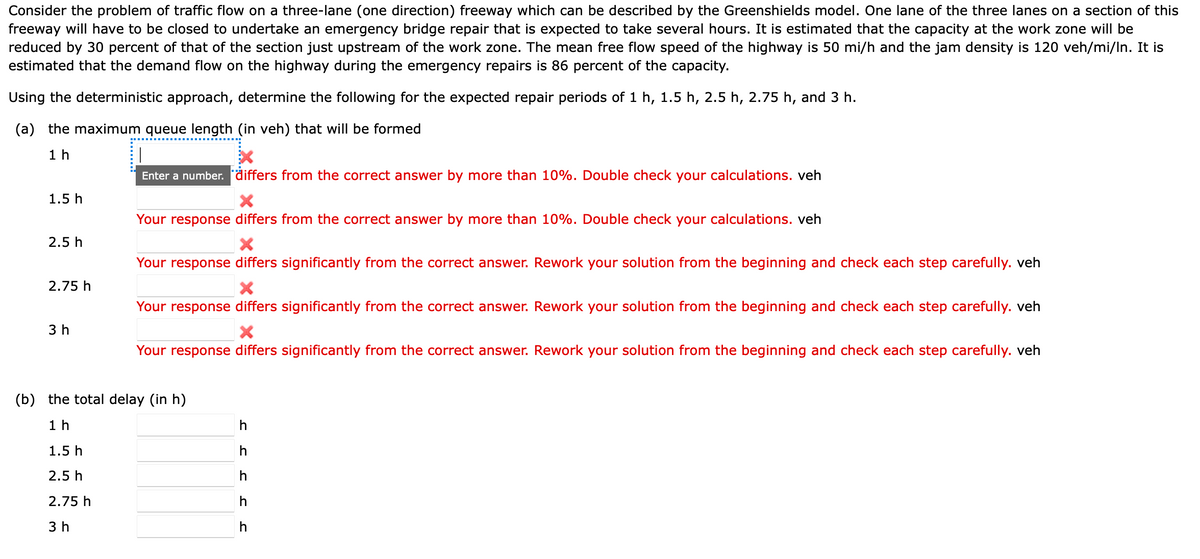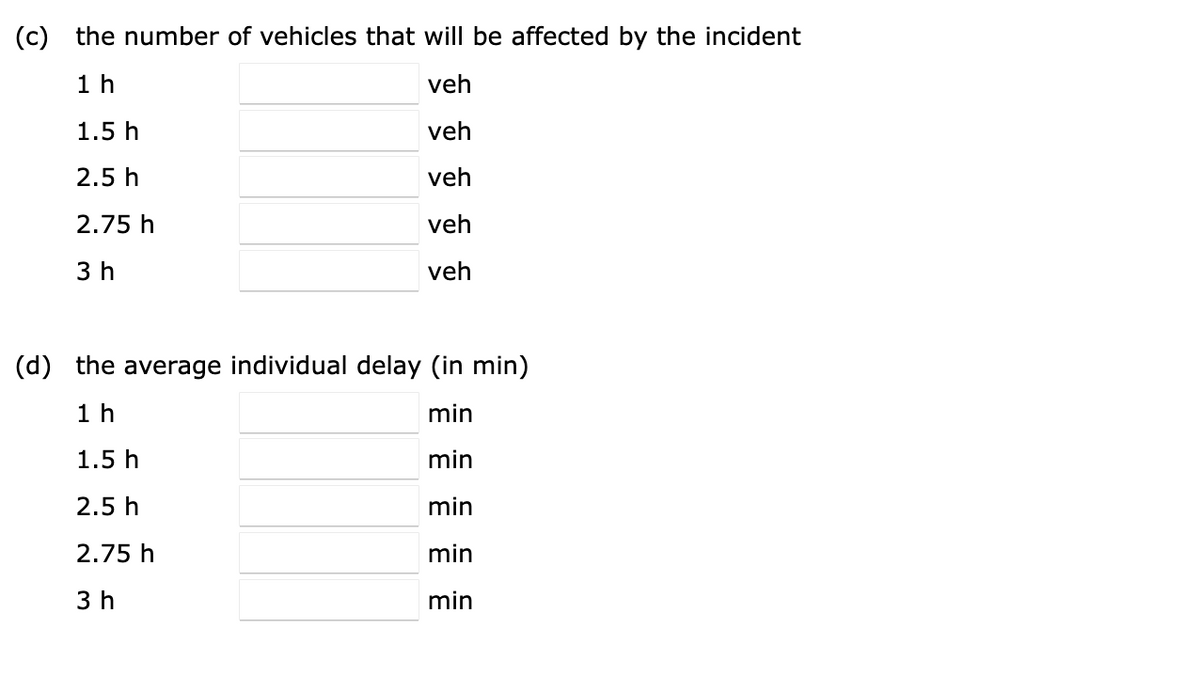Consider the problem of traffic flow on a three-lane (one direction) freeway which can be described by the Greenshields model. One lane of the three lanes on a section of this freeway will have to be closed to undertake an emergency bridge repair that is expected to take several hours. It is estimated that the capacity at the work zone will be reduced by 30 percent of that of the section just upstream of the work zone. The mean free flow speed of the highway is 50 mi/h and the jam density is 120 veh/mi/In. It is estimated that the demand flow on the highway during the emergency repairs is 86 percent of the capacity. Using the deterministic approach, determine the following for the expected repair periods of 1 h, 1.5 h, 2.5 h, 2.75 h, and 3 h. (a) the maximum queue length (in veh) that will be formed 1 h 1.5 h 2.5 h 2.75 h 3h Enter a number. differs from the correct answer by more than 10%. Double check your calculations. veh X Your response differs from the correct answer by more than 10%. Double check your calculations. veh 1.5 h 2.5 h 2.75 h 3 h X Your response differs significantly from the correct answer. Rework your solution from the beginning and check each step carefully. veh X Your response differs significantly from the correct answer. Rework your solution from the beginning and check each step carefully. veh X Your response differs significantly from the correct answer. Rework your solution from the beginning and check each step carefully. veh (b) the total delay (in h) 1 h h h h h h
Consider the problem of traffic flow on a three-lane (one direction) freeway which can be described by the Greenshields model. One lane of the three lanes on a section of this freeway will have to be closed to undertake an emergency bridge repair that is expected to take several hours. It is estimated that the capacity at the work zone will be reduced by 30 percent of that of the section just upstream of the work zone. The mean free flow speed of the highway is 50 mi/h and the jam density is 120 veh/mi/In. It is estimated that the demand flow on the highway during the emergency repairs is 86 percent of the capacity. Using the deterministic approach, determine the following for the expected repair periods of 1 h, 1.5 h, 2.5 h, 2.75 h, and 3 h. (a) the maximum queue length (in veh) that will be formed 1 h 1.5 h 2.5 h 2.75 h 3h Enter a number. differs from the correct answer by more than 10%. Double check your calculations. veh X Your response differs from the correct answer by more than 10%. Double check your calculations. veh 1.5 h 2.5 h 2.75 h 3 h X Your response differs significantly from the correct answer. Rework your solution from the beginning and check each step carefully. veh X Your response differs significantly from the correct answer. Rework your solution from the beginning and check each step carefully. veh X Your response differs significantly from the correct answer. Rework your solution from the beginning and check each step carefully. veh (b) the total delay (in h) 1 h h h h h h
Traffic and Highway Engineering
5th Edition
ISBN:9781305156241
Author:Garber, Nicholas J.
Publisher:Garber, Nicholas J.
Chapter6: Fundamental Principles Of Traffic Flow
Section: Chapter Questions
Problem 21P
Related questions
Question

Transcribed Image Text:Consider the problem of traffic flow on a three-lane (one direction) freeway which can be described by the Greenshields model. One lane of the three lanes on section of this
freeway will have to be closed to undertake an emergency bridge repair that is expected to take several hours. It is estimated that the capacity at the work zone will be
reduced by 30 percent of that of the section just upstream of the work zone. The mean free flow speed of the highway is 50 mi/h and the jam density is 120 veh/mi/In. It is
estimated that the demand flow on the highway during the emergency repairs is 86 percent of the capacity.
Using the deterministic approach, determine the following for the expected repair periods of 1 h, 1.5 h, 2.5 h, 2.75 h, and 3 h.
(a) the maximum queue length (in veh) that will be formed
1 h
1.5 h
2.5 h
2.75 h
3 h
Enter a number. differs from the correct answer by more than 10%. Double check your calculations. veh
X
Your response differs from the correct answer by more than 10%. Double check your calculations. veh
X
Your response differs significantly from the correct answer. Rework your solution from the beginning and check each step carefully. veh
X
Your response differs significantly from the correct answer. Rework your solution from the beginning and check each step carefully. veh
Your response differs significantly from the correct answer. Rework your solution from the beginning and check each step carefully. veh
(b) the total delay (in h)
1 h
1.5 h
2.5 h
2.75 h
3 h
h
h
h
C

Transcribed Image Text:(c) the number of vehicles that will be affected by the incident
1 h
veh
1.5 h
veh
2.5 h
veh
2.75 h
veh
3 h
veh
(d) the average individual delay (in min)
1 h
min
1.5 h
min
2.5 h
min
2.75 h
min
3 h
min
Expert Solution
This question has been solved!
Explore an expertly crafted, step-by-step solution for a thorough understanding of key concepts.
Step by step
Solved in 5 steps with 5 images

Knowledge Booster
Learn more about
Need a deep-dive on the concept behind this application? Look no further. Learn more about this topic, civil-engineering and related others by exploring similar questions and additional content below.Recommended textbooks for you

Traffic and Highway Engineering
Civil Engineering
ISBN:
9781305156241
Author:
Garber, Nicholas J.
Publisher:
Cengage Learning

Traffic and Highway Engineering
Civil Engineering
ISBN:
9781305156241
Author:
Garber, Nicholas J.
Publisher:
Cengage Learning